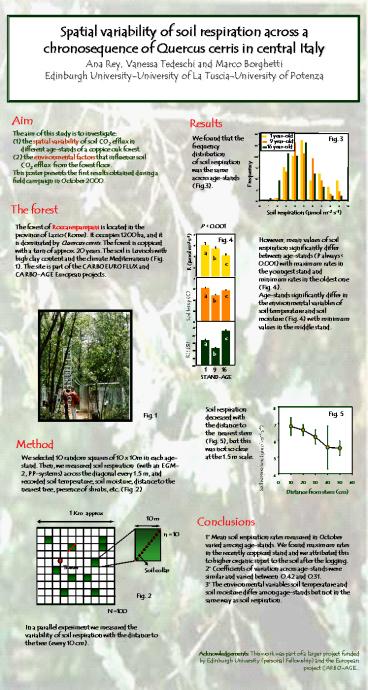Spatial variability of soil respiration across a
1 / 1
Title:
Spatial variability of soil respiration across a
Description:
... to the nearest tree, presence of shrubs, etc. (Fig 2) Fig. 1 ... the variability of soil respiration with the distance to the tree (every 10 cm). Fig. 5 ... –
Number of Views:51
Avg rating:3.0/5.0
Title: Spatial variability of soil respiration across a
1
Spatial variability of soil respiration across
a chronosequence of Quercus cerris in central
Italy Ana Rey, Vanessa Tedeschi and Marco
Borghetti Edinburgh University-University of La
Tuscia-University of Potenza
Aim
Results
The aim of this study is to investigate (1) the
spatial variability of soil CO2 efflux in
different age-stands of a coppice oak
forest. (2) the environmental factors that
influence soil CO2 efflux from the forest
floor. This poster presents the first results
obtained during a field campaign in October 2000.
30
1 year-old
Fig. 3
We found that the frequency distribution of soil
respiration was the same across
age-stands (Fig.3).
9 year-old
16 year-old
25
20
Frequency
15
10
5
0
The forest
0
1
2
3
4
5
6
7
8
9
10
Soil respiration (mmol m-2 s-1)
The forest of Roccarespampani is located in the
province of Lazio (Rome). It occupies 1200 ha,
and it is dominated by Quercus cerris. The forest
is coppiced with a turn of approx. 20 years. The
soil is Luvisols with high clay content and the
climate Mediterranean (Fig. 1). The site is part
of the CARBOEUROFLUX and CARBO-AGE European
projects.
P lt 0.001
6
Fig. 4
However, mean values of soil respiration
significantly differ between age-stands (P always
lt 0.001) with maximum rates in the youngest stand
and minimum rates in the oldest one (Fig.
4). Age-stands significantly differ in the
environmental variables of soil temperature and
soil moisture (Fig. 4) with minimum values in the
middle stand.
1
s
5
R (mmol m-2 s-1)
a
b
4
c
3
2
Soil temp (C)
15
a
c
b
14
13
12
RH ()
45
40
c
a
35
30
b
25
20
1 9 16
STAND-AGE
Soil respiration decreased with the distance to
the nearest stem (Fig. 5), but this was not so
clear at the 1.5 m scale.
8
Fig. 5
Fig. 1
Soil respiration (mmol m-2 s-1)
7
Method
6
We selected 10 random squares of 10 x 10m in each
age-stand. Then, we measured soil respiration
(with an EGM-2, PP-systems) across the diagonal
every 1.5 m, and recorded soil temperature, soil
moisture, distance to the nearest tree, presence
of shrubs, etc. (Fig 2)
5
4
0
10
20
30
40
50
60
Distance from stem (cm)
1 Km
approx
Conclusions
10 m
n 10
1 Mean soil respiration rates measured in
October varied among age-stands. We found maximum
rates in the recently coppiced stand and we
attributed this to higher organic input to the
soil after the logging. 2 Coefficients of
variation across age-stands were similar and
varied between 0.42 and 0.31. 3 The
environmental variables soil temperature and soil
moisture differ among age-stands but not in the
same way as soil respiration.
Tower
Soil collar
Fig. 2
N 100
In a parallel experiment we measured the
variability of soil respiration with the distance
to the tree (every 10 cm).
Acknowledgements This work was part of a larger
project funded by Edinburgh University (personal
Fellowship) and the European project CARBO-AGE..































